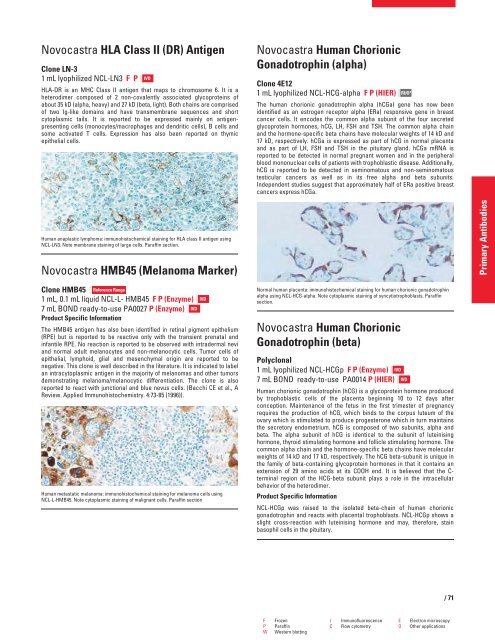QF0159 Marketing Release Record
QF0159 Marketing Release Record
QF0159 Marketing Release Record
Create successful ePaper yourself
Turn your PDF publications into a flip-book with our unique Google optimized e-Paper software.
Novocastra HLA Class II (DR) Antigen<br />
Clone LN-3<br />
1 mL lyophilized NCL-LN3 FP<br />
HLA-DR is an MHC Class II antigen that maps to chromosome 6. It is a<br />
heterodimer composed of 2 non-covalently associated glycoproteins of<br />
about 35 kD (alpha, heavy) and 27 kD (beta, light). Both chains are comprised<br />
of two Ig-like domains and have transmembrane sequences and short<br />
cytoplasmic tails. It is reported to be expressed mainly on antigenpresenting<br />
cells (monocytes/macrophages and dendritic cells), B cells and<br />
some activated T cells. Expression has also been reported on thymic<br />
epithelial cells.<br />
Human anaplastic lymphoma: immunohistochemical staining for HLA class II antigen using<br />
NCL-LN3. Note membrane staining of large cells. Paraffin section.<br />
Novocastra HMB45 (Melanoma Marker)<br />
Clone HMB45 Reference Range<br />
1 mL, 0.1 mL liquid NCL-L- HMB45 F P (Enzyme)<br />
7 mL BOND ready-to-use PA0027 P (Enzyme)<br />
Product Specific Information<br />
The HMB45 antigen has also been identified in retinal pigment epithelium<br />
(RPE) but is reported to be reactive only with the transient prenatal and<br />
infantile RPE. No reaction is reported to be observed with intradermal nevi<br />
and normal adult melanocytes and non-melanocytic cells. Tumor cells of<br />
epithelial, lymphoid, glial and mesenchymal origin are reported to be<br />
negative. This clone is well described in the literature. It is indicated to label<br />
an intracytoplasmic antigen in the majority of melanomas and other tumors<br />
demonstrating melanoma/melanocytic differentiation. The clone is also<br />
reported to react with junctional and blue nevus cells. (Bacchi CE et al., A<br />
Review. Applied Immunohistochemistry. 4:73-85 (1996)).<br />
Human metastatic melanoma: immunohistochemical staining for melanoma cells using<br />
NCL-L-HMB45. Note cytoplasmic staining of malignant cells. Paraffin section<br />
IVD<br />
IVD<br />
IVD<br />
Novocastra Human Chorionic<br />
Gonadotrophin (alpha)<br />
Clone 4E12<br />
1 mL lyophilized NCL-HCG-alpha F P (HIER)<br />
The human chorionic gonadotrophin alpha (hCGa) gene has now been<br />
identified as an estrogen receptor alpha (ERa) responsive gene in breast<br />
cancer cells. It encodes the common alpha subunit of the four secreted<br />
glycoprotein hormones, hCG, LH, FSH and TSH. The common alpha chain<br />
and the hormone-specific beta chains have molecular weights of 14 kD and<br />
17 kD, respectively. hCGa is expressed as part of hCG in normal placenta<br />
and as part of LH, FSH and TSH in the pituitary gland. hCGa mRNA is<br />
reported to be detected in normal pregnant women and in the peripheral<br />
blood mononuclear cells of patients with trophoblastic disease. Additionally,<br />
hCG is reported to be detected in seminomatous and non-seminomatous<br />
testicular cancers as well as in its free alpha and beta subunits.<br />
Independent studies suggest that approximately half of ERa positive breast<br />
cancers express hCGa.<br />
Normal human placenta: immunohistochemical staining for human chorionic gonadotrophin<br />
alpha using NCL-HCG-alpha. Note cytoplasmic staining of syncytiotrophoblasts. Paraffin<br />
section.<br />
Novocastra Human Chorionic<br />
Gonadotrophin (beta)<br />
Polyclonal<br />
1 mL lyophilized NCL-HCGp F P (Enzyme)<br />
7 mL BOND ready-to-use PA0014 P (HIER)<br />
Human chorionic gonadotrophin (hCG) is a glycoprotein hormone produced<br />
by trophoblastic cells of the placenta beginning 10 to 12 days after<br />
conception. Maintenance of the fetus in the first trimester of pregnancy<br />
requires the production of hCG, which binds to the corpus luteum of the<br />
ovary which is stimulated to produce progesterone which in turn maintains<br />
the secretory endometrium. hCG is composed of two subunits, alpha and<br />
beta. The alpha subunit of hCG is identical to the subunit of luteinising<br />
hormone, thyroid stimulating hormone and follicle stimulating hormone. The<br />
common alpha chain and the hormone-specific beta chains have molecular<br />
weights of 14 kD and 17 kD, respectively. The hCG beta-subunit is unique in<br />
the family of beta-containing glycoprotein hormones in that it contains an<br />
extension of 29 amino acids at its COOH end. It is believed that the Cterminal<br />
region of the HCG-beta subunit plays a role in the intracellular<br />
behavior of the heterodimer.<br />
Product Specific Information<br />
NCL-HCGp was raised to the isolated beta-chain of human chorionic<br />
gonadotrophin and reacts with placental trophoblasts. NCL-HCGp shows a<br />
slight cross-reaction with luteinising hormone and may, therefore, stain<br />
basophil cells in the pituitary.<br />
F Frozen I Immunofluorescence E Electron microscopy<br />
P Paraffin C Flow cytometry O Other applications<br />
W Western blotting<br />
IVD<br />
RUO*<br />
IVD<br />
/71<br />
Primary Antibodies
















